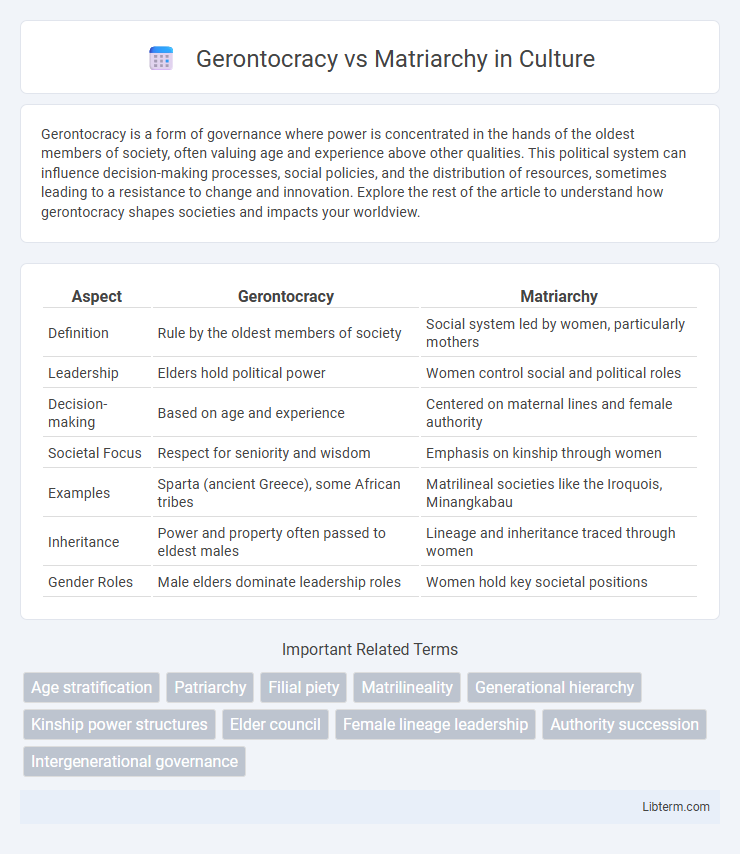Gerontocracy is a form of governance where power is concentrated in the hands of the oldest members of society, often valuing age and experience above other qualities. This political system can influence decision-making processes, social policies, and the distribution of resources, sometimes leading to a resistance to change and innovation. Explore the rest of the article to understand how gerontocracy shapes societies and impacts your worldview.
Table of Comparison
| Aspect | Gerontocracy | Matriarchy |
|---|---|---|
| Definition | Rule by the oldest members of society | Social system led by women, particularly mothers |
| Leadership | Elders hold political power | Women control social and political roles |
| Decision-making | Based on age and experience | Centered on maternal lines and female authority |
| Societal Focus | Respect for seniority and wisdom | Emphasis on kinship through women |
| Examples | Sparta (ancient Greece), some African tribes | Matrilineal societies like the Iroquois, Minangkabau |
| Inheritance | Power and property often passed to eldest males | Lineage and inheritance traced through women |
| Gender Roles | Male elders dominate leadership roles | Women hold key societal positions |
Defining Gerontocracy and Matriarchy
Gerontocracy is a social and political system where leadership and authority are primarily held by the oldest members of a community, emphasizing seniority and experience in governance. Matriarchy, in contrast, is a societal structure where women, particularly mothers, hold central roles in political leadership, moral authority, and control over property and social organization. Both systems influence power dynamics and cultural organization by prioritizing different criteria for leadership--age in gerontocracy and gender in matriarchy.
Historical Roots of Gerontocracy
Gerontocracy, a system of governance by the elderly, traces its historical roots to ancient societies where seniority symbolized wisdom and experience, such as in early African and Polynesian tribes. These societies often valued elders for their accumulated knowledge, which was essential for decision-making and conflict resolution, contrasting with matriarchal structures that emphasized female lineage and leadership. The institutionalization of gerontocracy is evident in councils of elders that shaped political, social, and religious frameworks across civilizations.
Origins and Evolution of Matriarchy
The origins of matriarchy trace back to prehistoric societies where female leadership was prominent in social and religious structures, often linked to fertility cults and earth-based spirituality. Over time, these societies evolved with women holding central authority roles in kinship, property inheritance, and community governance, contrasting with gerontocracy, which centers power among elders regardless of gender. Archaeological evidence and anthropological studies reveal that matriarchal systems influenced early human civilization development before the rise of patriarchal and gerontocratic models.
Power Structures: Age vs Gender
Gerontocracy centers power in the hands of the oldest members of society, emphasizing age as the primary criterion for authority and decision-making roles. Matriarchy, in contrast, allocates power based on gender, with leadership and social dominance vested predominantly in women. These distinct power structures reflect differing societal values, where gerontocracy upholds experience and seniority, while matriarchy prioritizes female lineage and maternal influence.
Cultural Examples of Gerontocratic Societies
Gerontocracy, a social system where elders hold primary power, is prominently observed in the Igbo communities of Nigeria and the Council of Elders in Native American tribes like the Iroquois Confederacy. These societies emphasize the wisdom and experience of senior members in decision-making and conflict resolution. Contrasting with matriarchy, where women have dominant roles, gerontocratic cultures prioritize age and seniority regardless of gender.
Matriarchal Societies Around the World
Matriarchal societies, such as the Mosuo in China and the Minangkabau in Indonesia, emphasize female leadership in social, economic, and familial roles, often tracing lineage through the mother's line. These cultures prioritize communal decision-making and inheritance via maternal descent, contrasting with gerontocratic systems where elders, typically male, hold primary authority. Anthropological studies highlight that matriarchal structures contribute to more egalitarian gender relations and influence societal stability in various indigenous communities worldwide.
Social Impacts of Gerontocracy
Gerontocracy, a system where leadership is dominated by the elderly, often results in social rigidity and resistance to innovation, affecting generational equity and youth representation in decision-making processes. This leadership structure can perpetuate entrenched social hierarchies, limiting opportunities for younger demographics and potentially slowing societal progress. In contrast to matriarchal societies often characterized by communal and inclusive governance, gerontocracy may prioritize the preservation of traditional values over adaptive social policies.
Gender Dynamics in Matriarchal Systems
Matriarchal systems center on female leadership, significantly influencing gender dynamics by elevating women's roles in social, political, and economic spheres. Unlike gerontocracy, where power is held predominantly by elders, matriarchies emphasize maternal lineage and communal decision-making, often fostering more inclusive gender participation. These systems challenge traditional patriarchy by redefining authority and status through gender, promoting gender equality and social cohesion.
Gerontocracy vs Matriarchy: Key Differences
Gerontocracy centers power in the hands of the oldest members of society, emphasizing age and seniority as the primary criteria for leadership and decision-making. Matriarchy, by contrast, places authority within female leadership, often focusing on lineage and social organization through maternal lines. Key differences lie in the basis of authority--age versus gender--and the societal roles and influence each system promotes.
Future Trends in Leadership Models
Gerontocracy, characterized by leadership dominated by elders, may face challenges as societies increasingly value innovation and technological adaptability, prompting shifts toward more diverse leadership models. Matriarchy, emphasizing female authority and communal cooperation, is gaining attention for fostering inclusive decision-making and social equity, aligning with global trends toward gender equality. Emerging leadership frameworks are likely to blend elements of both, promoting intergenerational collaboration and gender-balanced governance to address complex future challenges.
Gerontocracy Infographic

 libterm.com
libterm.com